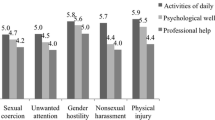Abstract
The purpose of this study was to investigate differences in perceptions of two “severity dichotomies” present in the Equal Employment Opportunity Commission Guidelines on sexual harassment. Alale and female undergraduates (N = 198), from a predominately white midwestern university, were given one of four statements based on these guidelines, varying “form” (physical/verbal) and “consequence” (economic injury/hostile environment) of the behavior. Analysis of variance results showed females rated the incident as more definitely sexual harassment and as affecting perfonnance more than did males. Participants reading “economic injury” statements rated them as having more effect on the victim’s job status than did those reading “hostile environment” statements. A multivariate analysis of variance revealed significant “consequence” and “sex” effects on several factors: A significant three-way interaction showed that males rated statements less negatively than did females, especially when the statement described “physical” behavior with “hostile environment“ consequences. Cluster analysis results are also presented.
Similar content being viewed by others
References
Abbey, A. (1982). Sex differences in attributions for friendly behavior: Do males misperceive females friendliness?Journal of Personality and Social Psychology, 42, 830–838.
Baxter, R. H. (1981).Sexual harassment in the workplace: A guide to the law. New York: Executive Enterprises Publications.
Cohen, A. G., & Gutek, B. A. (1985). Dimensions of perceptions of social-sexual behavior in a work setting.Sex Roles, 13, 317–327.
Coles, F. S. (1986). Forced to quit: Sexual harassment complaints and agency response.Sex Roles, 14, 81–95.
Collins, E. G. C., & Blodgett, T. B. (1981, March.April). Sexual harassment: Some see it... some don’t.Harvard Business Review, 59, 77–95.
Equal Employment Opportunity Commission (1980). Interpretive guidelines on sexual harassment.Federal Register, 45, 74677.
Gutek, B. A., Morasch, B., & Cohen, A. G. (1983). Interpreting social-sexual behavior in a work setting.Journal of Vocational Behavior, 22, 30–48.
Horgan, D. D., & Reeder, G. (1986). Sexual harassment.AAOHN Journal, 34, 83–86.
Jones, E. E., Kanouse, D. E., Kelley, H. H., Nisbett, R. E., Valins, S. E., & Weiner, B. (1972).Attribution: Perceiving the causes of behavior. Morristown, NJ: General Learning Press.
Kelley, H. H. (1973). The process of causal attribution.American Psychologist, 28, 107–128.
Kelley, H. H., & Michela, J. L: (1980). Attribution theory and research.Annual Review of Psychology, 31, 457–502.
Livingston, J. A. (1982). Responses to sexual harassment on the job: Legal, organizational, and individual actions.Journal of Social Issues, 38, 5–20.
Lorr, M. (1983).Cluster Analysis for Social Scientists. San Francisco: Jossey-Bass.
McKinney, K. M., & Maroules, N. (1991). Sexual harassment. In E. Grauerholz & M. A. Koralewski (Eds.),Sexual coercion. Lexington, MA: Lexington Books.
Meritor Savings Bank v. Vinson, 106 S. Ct 2399, 1986.1.
Padgitt, S. C., & Padgitt, J. S. (1986, January). Cognitive structure of sexual harassment: Implication of university policy.Journal of College Student Personnel, pp. 34–39.
Popovich, P. M., & Licata, B. J. (1987). A role model approach to sexual harassment.Journal of Management, 13, 149–161.
Popovich, P. M. & Nokovich-Gehlauf, D. (1989, May).The effects of physical attractil’eness on perceptions of sexual harassment. Paper presented at the meeting of the Midwestern Psychological Association, Chicago.
Popovich, P. M., Licata, B. J., Nokovich, D., Martelli, T., & Zoloty, S. (1986). Assessing the incidence and perceptions of sexual harassment behaviors among American undergraduates.The Journal of Psychology, 120, 387–396.
Pryor, J. B. (1985). The lay person’s understanding of sexual harassment.Sex Roles, 13, 273–286.
Pryor, J. B., & Day, J. D. (1988). Interpretations of sexual harassment: An attributional analysis.Sex Roles, 18, 405–417.
Schmidt, D. F., & Boland, S. M. (1986). Structure and perceptions of older adults: Evidence for multiple stereotypes.Psychology ofAging, 1, 255–260.
Terpstra, D. E., & Cook, S. E. (1985). Complainant characteristics and reported behaviors and consequences associated with formal sexual harassment charges.Personnel Psychology, 38, 559–574.
United States Merit Systems Protection Board (USMSPB) (1981).Sexual harassment in the federal workplace: Is it a problem? Washington, DC: U.S. Government Printing Office.
United States Merit Systems Protection Board (1988).Sexual harassment in the federal government: An update. Washington, DC: U.S. Government Printing Office.
Author information
Authors and Affiliations
Additional information
A previous version of this paper was presented at the 62nd annual meeting of the Midwestern Psychological Association, Chicago, May 1990.
Rights and permissions
About this article
Cite this article
Popovich, P.M., Gehlauf, D.N., Jolton, J.A. et al. Perceptions of sexual harassment as a function of sex of rater and incident form and consequence. Sex Roles 27, 609–625 (1992). https://doi.org/10.1007/BF03187137
Issue Date:
DOI: https://doi.org/10.1007/BF03187137




